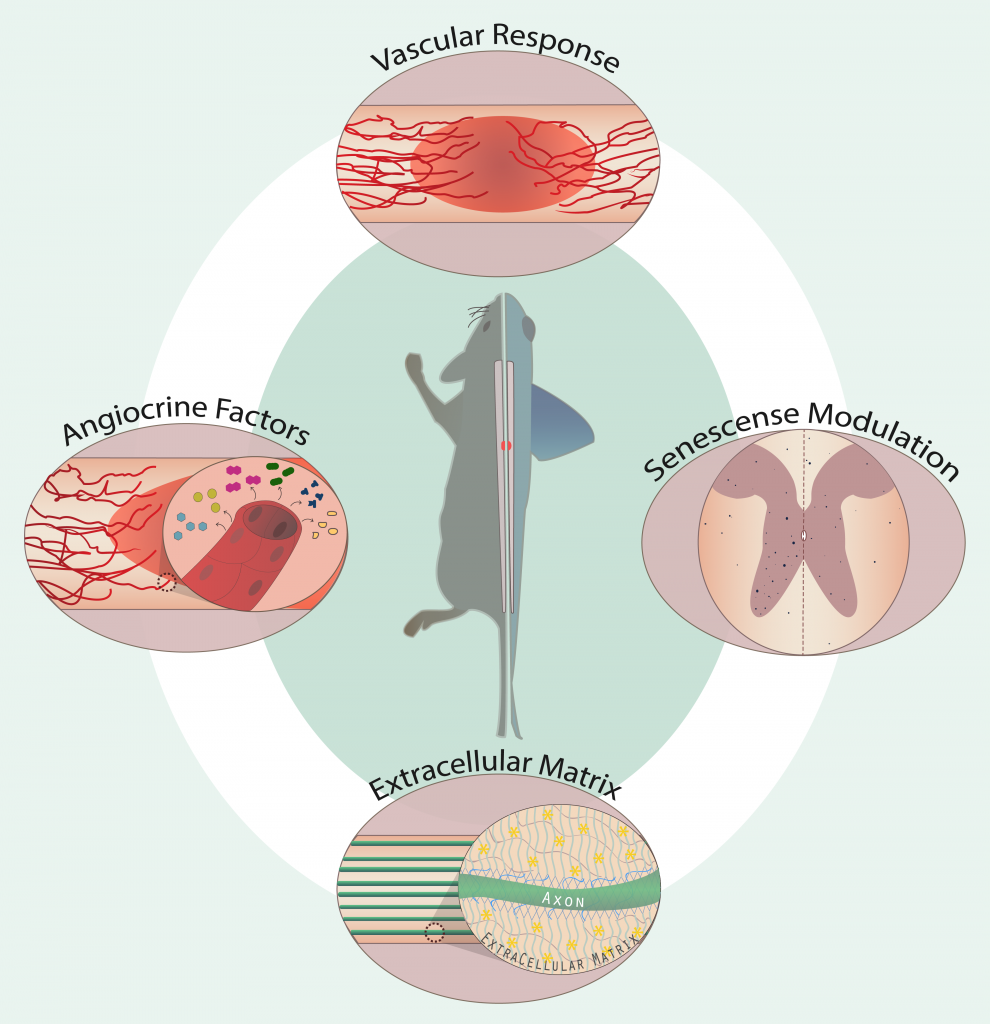Spinal Cord Regeneration & Tissue Microenvironment
Spinal cord injuries in humans render patients with permanent impairments due to lack of regeneration. In contrast, the zebrafish spinal cord has an amazing ability to recover from injuries, allowing these fish to swim again. In zebrafish, a spinal cord injury promotes proliferation of neural stem cells that reside in the spinal cord, and the same is probably true in mammals. Yet, the mammalian spinal cord microenvironment strongly suppresses regeneration, while the zebrafish supports it.
Our lab is fully committed to understand the biology of the tissue microenvironment of an injured spinal cord in a regenerating animal (i.e. the zebrafish) and in a non-regenerating animal (i.e. the mouse).
We believe that if we create a permissive microenvironment that favours regeneration, like the one in zebrafish, we will be able to improve considerably the motor and sensitive impairments that arise from a spinal cord injury in mammals.
Find us on Instagram @lsaudelab
Neuropal - Online game about safety and the nervous system
Neuropal aims to help recognise risky situations and adopt safe behaviours that may prevent serious injuries, while also exploring the anatomy of the nervous system and the important functions it performs.
The game takes us on an adventure with two friends, Neuropal and Neuro, vacationing on a tropical paradise where unexpected events force everyone to escape. Neuropal will have to move through different landscapes and challenges to leave the island safely. Every completed level can be replayed as many times as we want, to show off our new safety skills and improve our score. Neuropal also includes quizzes about safety and a glossary where we can explore more about the nervous system.
Check more here.


Research Team
Research Areas
- Vascular Remodelling
- Extracellular Matrix
- Senescent cells

Ongoing Research Projects
2023/2025 Endothelial CD9 as a new anti-inflammatory target to promote spinal repair. Coordinator: Isaura Martins. Funding Agency: Fundação para a Ciência e a Tecnologia.
2023/2025 Improving Spinal Cord REgenEration by modulating Neutrophil inflammation: lessons from a Zebrafish perspective. Coordinator: Carmen de Sena Tomás. Funding Agency: Fundação para a Ciência e a Tecnologia.
2022/2024 Do different telomere elongation mechanisms exist in regenerating spinal cords? Coordinator: Leonor Saúde. Funding Agency: Fundação para a Ciência e a Tecnologia.
2021/2023 Senescent cells and their secretory phenotype: novel targets for spinal cord repair. Coordinator: Leonor Saúde. Funding Agency: Santa Casa da Misericórdia de Lisboa.
2019/2022 Targeting induced-senescent cells: a novel approach to promote spinal cord regeneration in mammals Acronym: SENSe. Coordinator: Leonor Saúde. Funding Agency: Fundación Bancaria "la Caixa".
Awards
2022 Lídia Silva Santos Postdoctoral Achievement Award to Isaura Martins.
2022 4th Best Poster Presentation in XV CAML-V NeurULisboa PhD Students Meeting to Mariana Costa.
2021 Pfizer Award for Basic Research awarded to Leonor Saúde and her team.
2021 3rd Best Oral Presentation in XIV CAML-IV NeurULisboa PhD Students Meeting to Ana Filipa Isidro.
2021 Rising Star Award from Specanalítica to Dalila Silva.
2021 iMM Best Master Thesis Award to Leonor Lameira.
2021 Best Oral Presentation in iMed 13.0 Innovate Competition (Basic Research) to Leonor Lameira.
2012 L'Óréal Portugal Medals of Honor for Women in Science awarded to Ana Ribeiro.
2011 Olympus BioScapes Competition, Honorable Mention awarded to Rita Fior.
2005 Pfizer Award for Basic Research awarded to Leonor Saúde.
Selected Publications
Martins, I., Neves-Silva, D., Ascensão-Ferreira, M., Dias, A.F., Ribeiro, D., Isidro, A.F., Quitéria, R., Paramos-de-Carvalho, D., Barbosa-Morais, N.L., Saúde, L. Mouse Spinal Cord Vascular Transcriptome Analysis Identifies CD9 and MYLIP as Injury-Induced Players. Int. J. Mol. Sci. 2023, 24, 6433. https://doi.org/10.3390/ijms24076433
Isidro, A. F., Medeiros, A. M., Martins, I., Neves-Silva, D., Saúde, L., Mendes, C. S. (2023). Using the MouseWalker to Quantify Locomotor Dysfunction in a Mouse Model of Spinal Cord Injury. JoVE e65207, doi:10.3791/65207
Frederico B., Martins I., Chapela D., Gasparrini F., Chakravarty, P., Ackels T., Piot C., Almeida B., Carvalho J., Ciccarelli A., Peddie C.J., Rogers N., Briscoe J., Guillemot F., Schäfer A.T., Saúde L. and Reis e Sousa C. (2022). DNGR-1-tracing marks an ependymal cell subset with damage-responsive neural stem cell potential. Developmental Cell. DOI: https://doi.org/10.1016/j.devcel.2022.07.012.
Paramos-de-Carvalho D, Jacinto A, Saúde L (2021). The right time for senescence. Elife 10:e72449. doi: 10.7554/eLife.72449.
Paramos-de-Carvalho D, Martins I, Cristóvão AM, Dias AF, Pereira T, Chapela D, Farinho A, Neves-Silva D, Jacinto A, Saúde L (2021). Targeting senescent cells improves functional recovery after spinal cord injury. Cell Reports 36(1):109334. doi: 10.1016/j.celrep.2021.109334.
Chapela D., Sousa S, Martins I., Cristóvão A.M., Pinto P., Corte-Real S., Saúde L. A zebrafish drug screening platform boosts the discovery of novel therapeutics for spinal cord injury in mammals. Scientific Reports. (2019) 9(1):10475. doi: 10.1038/s41598-019-47006-w.
Ribeiro A, Monteiro JF, Certal AC, Cristovão AM and Saúde L. Foxj1a is expressed in ependymal precursors, controls central canal position and is activated in new ependymal cells during regeneration in zebrafish. Open Biology (2017) 7(11): 170139. doi: 10.1098/rsob.170139.
Mendes R.V., Martins G.G., Martins A.M. and Saúde L. N-cadherin locks left-right asymmetry by ending the leftward movement of Hensen’s node cells. Developmental Cell (2014) 30(3):353-60.
Fior R., Maxwell A.A., Ma T.P., Vezzaro A., Moens C.B., Amacher S.L., Lewis J. and Saúde L. Differentiation and movement of presomitic mesoderm progenitor cells are both controlled by Mesogenin1. Development (2012) 139(24): 4656-65.
Azevedo A.S., Sousa S., Jacinto A. and Saúde L. An amputation resets positional information to a proximal identity in the regenerating zebrafish caudal fin. BMC Developmental Biology (2012) 12(1):24 (selected hot topic of the August issue).
Azevedo A.S., Grotek B., Jacinto A., Weidinger G. and Saúde L. The regenerative capacity of the zebrafish caudal fin is not affected by repeated amputations. PloS ONE (2011), Vol. 6(7); e22820.
Useful Links
Related News
29.Nov.2018Chasing Questions | Leonor Saúde
- Group Leader at iMM since 2007
- Invited Associate Professor at FMUL
- Group Leader at Instituto Gulbenkian de Ciência (2005-07)
- Postdoctoral research at Instituto Gulbenkian de Ciência
- PhD in Developmental Biology at University College London, UK (2001)